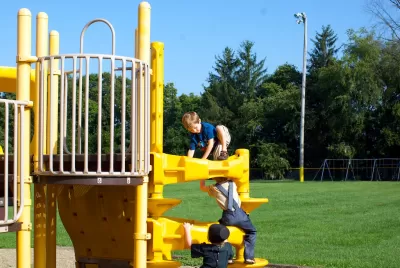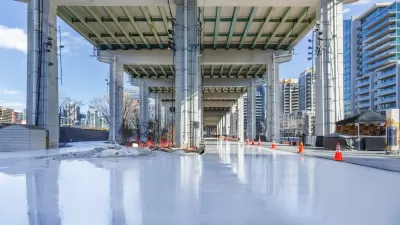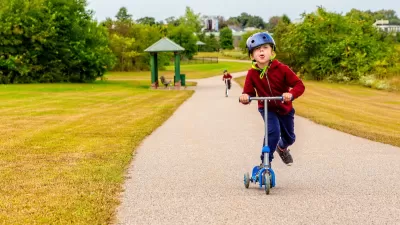Opening schoolyards to the public could be 'game-changing' for communities lacking in green space.

The Trust for Public Land's Community Schoolyards report highlights the potential for the country's public schoolyards to serve as public parks. The Trust "believes that transforming America’s schoolyards into shared public parks by 2030 is a common-sense, cost-effective solution to America’s park equity problem. Opening all public schoolyards during non-school hours would put a park within a 10-minute walk of nearly 20 million people—solving the problem of outdoor access for one-fifth of the nation’s 100 million people who don’t currently have a park close to home."
The report also outlines steps schools can take to make their schoolyards more inviting, healthy, and safe. These suggestions include "[s]wapping out blacktop for trees, gardens, and up-to-date play equipment," which "would deliver a raft of benefits to students, from emotional to academic."
According to analysis conducted by the Trust, "[i]n the 100 largest U.S. cities, neighborhoods where residents predominantly identify as people of color have access to an average of 44 percent less park acreage than predominantly white neighborhoods." Community Schoolyards seeks to reimagine the drab asphalt schoolyard as an inspiring, healthful environment for both students and the community at large. "Renovated schoolyards can also serve as vital green space for the entire community. Growing numbers of districts are allowing local residents to use their school grounds after school and on weekends, giving not only students but people of all ages new access to parkland."
FULL STORY: A game-changing solution to America’s park equity problem

Maui's Vacation Rental Debate Turns Ugly
Verbal attacks, misinformation campaigns and fistfights plague a high-stakes debate to convert thousands of vacation rentals into long-term housing.

Planetizen Federal Action Tracker
A weekly monitor of how Trump’s orders and actions are impacting planners and planning in America.

In Urban Planning, AI Prompting Could be the New Design Thinking
Creativity has long been key to great urban design. What if we see AI as our new creative partner?

King County Supportive Housing Program Offers Hope for Unhoused Residents
The county is taking a ‘Housing First’ approach that prioritizes getting people into housing, then offering wraparound supportive services.

Researchers Use AI to Get Clearer Picture of US Housing
Analysts are using artificial intelligence to supercharge their research by allowing them to comb through data faster. Though these AI tools can be error prone, they save time and housing researchers are optimistic about the future.

Making Shared Micromobility More Inclusive
Cities and shared mobility system operators can do more to include people with disabilities in planning and operations, per a new report.
Urban Design for Planners 1: Software Tools
This six-course series explores essential urban design concepts using open source software and equips planners with the tools they need to participate fully in the urban design process.
Planning for Universal Design
Learn the tools for implementing Universal Design in planning regulations.
planning NEXT
Appalachian Highlands Housing Partners
Gallatin County Department of Planning & Community Development
Mpact (founded as Rail~Volution)
City of Camden Redevelopment Agency
City of Astoria
City of Portland
City of Laramie





























